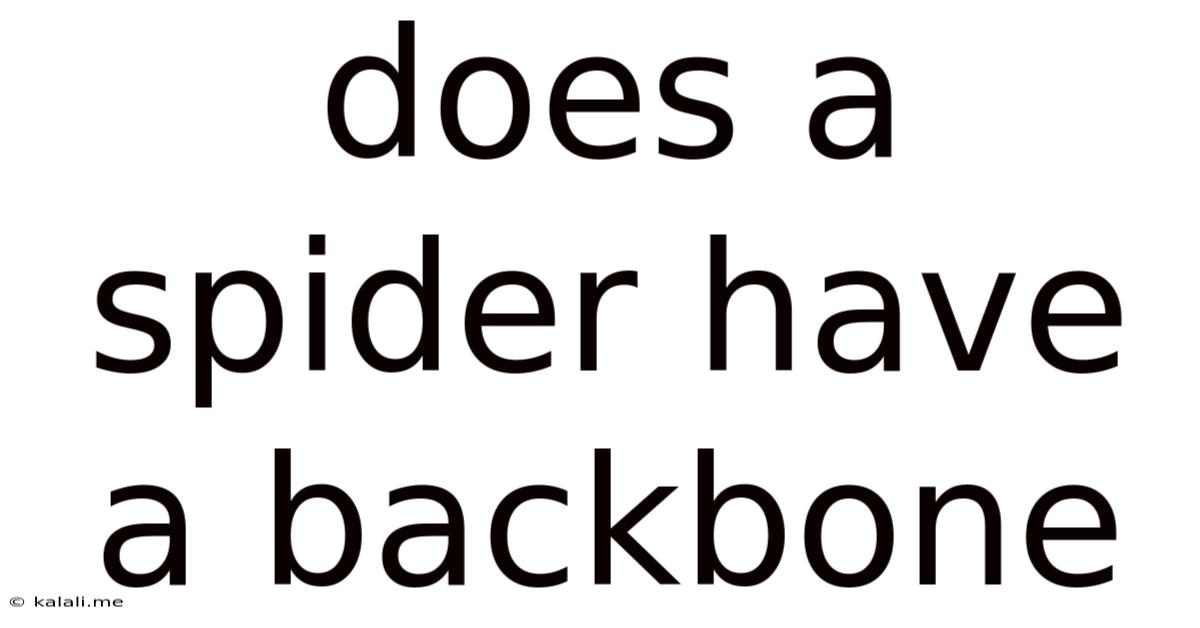Does A Spider Have A Backbone
Kalali
Jun 11, 2025 · 2 min read

Table of Contents
Does a Spider Have a Backbone? Understanding Arachnid Anatomy
Do spiders have backbones? The short answer is a resounding no. Spiders, along with scorpions, mites, and ticks, belong to a group called arachnids. Arachnids are invertebrates, meaning they lack a vertebral column, commonly known as a backbone or spine. This key difference sets them apart from vertebrates like humans, dogs, birds, and fish. This article delves deeper into the anatomy of spiders, explaining why they don't possess a backbone and highlighting the characteristics that define them as invertebrates.
What Defines an Invertebrate?
Invertebrates are animals without a backbone or spinal column. This is a vast group encompassing a wide variety of creatures, representing over 90% of all animal species. The absence of a backbone is a fundamental characteristic, leading to diverse body plans and adaptations across different invertebrate phyla. Instead of an internal skeleton, many invertebrates possess an exoskeleton, a hard external covering that provides protection and support.
The Spider's Exoskeleton and Internal Structure
Spiders, as invertebrates, lack a backbone but possess a robust exoskeleton made of chitin. This exoskeleton protects their internal organs and provides structural support. Beneath the exoskeleton lies a complex internal structure. While they don't have bones, they have a hardened cephalothorax (fused head and chest) and an abdomen. Their legs are jointed, allowing for a wide range of movement. Their internal organs, including their heart, digestive system, and reproductive organs, are arranged within this body plan.
How Spiders Move Without a Backbone
The absence of a backbone doesn't limit spider mobility. Their eight legs, powered by powerful muscles and articulated joints, enable them to walk, jump, climb, and even build intricate webs. The hydraulic pressure within their legs also plays a crucial role in their movements, contributing to their agility and precision.
Comparing Spiders to Vertebrates
The contrast between a spider and a vertebrate is striking. Vertebrates possess an internal skeleton with a backbone providing structural support and protection for the spinal cord. This internal framework allows for greater flexibility and size variation compared to the exoskeleton-based support system of spiders. The complexity of vertebrate nervous systems is also significantly more advanced than in invertebrates like spiders, although spider nervous systems are still highly sophisticated for their hunting and web-building behaviors.
Key Differences Summarized:
| Feature | Spider (Invertebrate) | Vertebrate (e.g., Human) |
|---|---|---|
| Backbone | Absent | Present |
| Skeleton | Exoskeleton | Endoskeleton |
| Number of Legs | Eight | Two or Four |
| Body Structure | Cephalothorax & Abdomen | Head, Torso, Limbs |
Understanding the anatomical differences between invertebrates and vertebrates helps us appreciate the incredible diversity of life on Earth. Spiders, despite lacking a backbone, are remarkably successful creatures with sophisticated adaptations enabling them to thrive in diverse habitats. Their unique anatomy, with its exoskeleton and highly efficient movement system, is a testament to the beauty and complexity of the natural world.
Latest Posts
Latest Posts
-
Elvis Presley Gospel One Pair Of Hands
Jul 01, 2025
-
What Is The Fine For Killing A Buzzard
Jul 01, 2025
-
How Old Am I If I Was Born In 1996
Jul 01, 2025
-
What Is 3 X 3 X 3
Jul 01, 2025
-
How Many Apples In A 3 Pound Bag
Jul 01, 2025
Related Post
Thank you for visiting our website which covers about Does A Spider Have A Backbone . We hope the information provided has been useful to you. Feel free to contact us if you have any questions or need further assistance. See you next time and don't miss to bookmark.